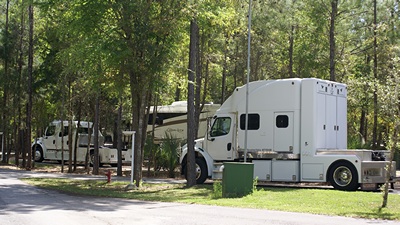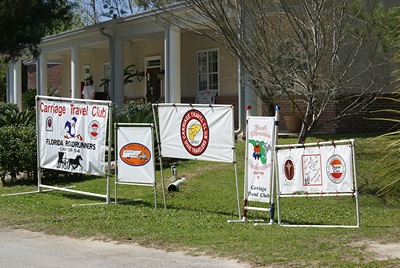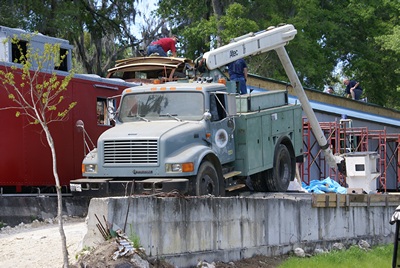AALL*BRITE showed up this morning as scheduled to wash the coach and clean/polish/seal the Alcoa wheels. The three man crew started on the roof and worked their way down and around. They used a “spot-free rinse system” that did not require them to hand dry the coach. When they were done with the wash and rinse they went to work on the wheels which were a messy job that involved a lot of hand work. The coach looked good when they were finished.
I went down mid-morning to check on Jeff and Kathy’s motorhome. Everything had worked through the night. I went back later and disconnected John’s 20 A battery charger. I then had Jeff disconnect the +12 VDC house battery cable. With the converter 120 VAC power cord was still unplugged the voltage at the converter output terminals was zero, as it should be. I plugged the 120 VAC cable back in and re-checked the voltage at the output terminals. It measured 13.5 VDC so the converter was, in fact, producing an appropriate voltage with no load attached. That did not prove that it was functioning properly as it could still be unable to maintain that voltage while supplying current to a load, but it was at least trying to do something.
The house battery bank had been disconnected for over 15 minutes. The resting voltage was 12.7 VDC, so the batteries were fully charged. My best guess was that Jeff and Kathy did not have a battery problem. I unplugged the converter and reattached the DC negative cable. We then reconnected the battery bank positive cable and plugged the converter power cord back in. The voltage measured 12.68 VDC. We decided to leave it this way and check it every couple of hours.
The RV technician who does work in the park stopped by and talked to Jeff for 5 minutes. He said he would order a new converter and schedule them for service on Wednesday, April 9. Apparently he presumed that Jeff and Kathy were being taken care of in the meantime as he offered no assistance or suggestions for how they might keep their rig functioning for the next five days.
Over the next four hours the voltage gradually dropped to 12.45 VDC, strongly suggesting that the converter was not maintaining the charge on the batteries. Just before dinner we unplugged the converter 120 VAC power cord and reconnected the 20 A battery charger. Later at the fire pit Kathy mentioned that the air-conditioners had stopped working so I walked over to check the situation. I found the battery charger set incorrectly, so I reset it, but I was not able to get the HVAC controller/thermostat to turn either unit on.
We spent the rest of the evening at the fire pit talking and enjoying Smiity’s music. Our friends from Ontario, Jack, Silvia, Doug, and Paulette came for a while and Smitty did quite a few Gordon Lightfoot songs. (I don’t know if Canadians like Gordon Lightfoot more than anyone else. He is certainly one of our favorite singer/songwriters.) Kathy brought down a couple of bottles of Moscato as a thank you for helping them with their electrical problem. That wasn’t necessary, but I certainly appreciate it. Charles and Sandy joined us for a while. They have relocated here from Texas and are looking to buy a business and settle in.
By 9:30 PM it was just John, Ali, Linda, and me. John has assumed increased volunteer duties at WCRVR from April 1 through November that include closing up various buildings at night. I spread the fire logs out on the grate and we returned to our rigs while John attended to his chores.


